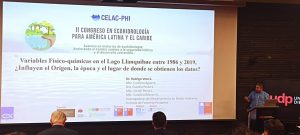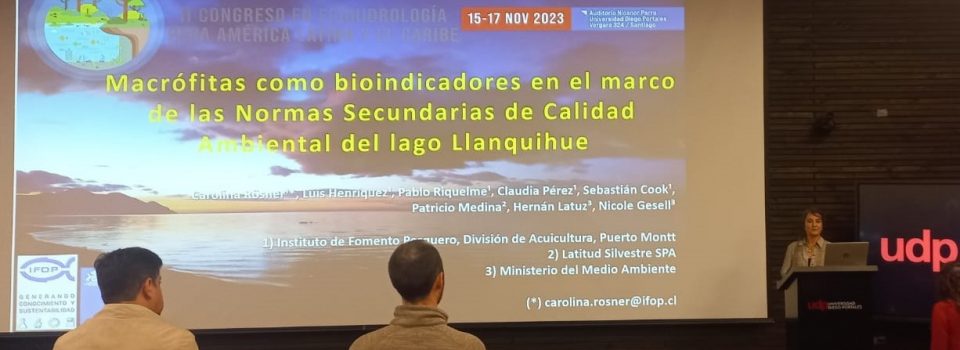Participation of IFOP researchers, Carolina Rösner and Rodrigo Vera in the Second Congress of Ecohydrology
November 28th, 2023 Between November 15th and 17th, the Second Ecohydrology Congress was held at Universidad Diego Portales in Santiago. The activity brought together experts to address current challenges in water management and environmental sustainability in the country. Researchers Carolina Rosner and Rodrigo Vera participated from IFOP.
Between November 15th and 17th, the Second Ecohydrology Congress was held at Universidad Diego Portales in Santiago. The activity brought together experts to address current challenges in water management and environmental sustainability in the country. Researchers Carolina Rosner and Rodrigo Vera participated from IFOP.
IFOP presentations
Mcs. Carolina Rösner had the title “Macrophytes as bioindicators within Lake Llanquihue’s Secondary Environmental Quality Standards framework”. Macrophytes are considered good environmental quality indicators of a lake system, helping to identify trophy and quality degree of waters that surround them, since they are sensitive to changes in physical-chemical quality. Therefore, macrophyte communities characteristics present in a certain place reflect existing quality conditions during the last months or even years, which could be the disappearance or appearance of a species, or changes in its relative abundance, which is highly significant information.
In this context, a study was carried out on macrophytes in Lake Llanquihue, second largest lake in Chile, and which since 2009 has had a Secondary Environmental Quality Standard, whose objective is to establish limits for the lake’s eutrophication levels.This standard also considers biological indicators use in a complementary manner to water quality control, including macrophyte communities abundance and composition in the four surveillance areas (Puerto Varas, Frutillar, Puerto Octay and Ensenada).
In this study, the presence of a total of 36 macrophyte species and one macroalgae was recorded. To determine the lake’s trophy levels, two methods based on macrophytes were used, San Martín method et al. 2003 and ITFM index (Urrutia et al. 2015), which yielded similar results. When comparing the trophy based on coverage, it was obtained that in general stations presented a low to medium trophy. As species tolerant to eutrophication, the following were identified: Cyperus xanthostachyus, Hydrocotyle ranunculoides, Impatiens glandulifera, Nasturtium officinale, Polygonum persicaria, Raphanus sativus, Sonchus oleraceus, and Trifolium pratense. Of them, only C. xanthostachyus is native.
Meanwhile, the indicator species of oligotrophy were: Equisetum bogotense, Isolepis cernua, Nitella aff. acuminata, Rumex acetosella, and Trifolium campestre, of which the last two are introduced. The rest of the species were considered indifferent regarding eutrophication. Abundance patterns indicating serious eutrophication impacts, such as excessive increase in marsh macrophytes or single tolerant species dominance, were absent. This may be associated with the lake’s conditions ,as well as with the methodology used for submerged macrophytes research, suggesting that future study areas location should be directed to areas with discharges from point sources, where a relationship is found between abundance of this species and nutrient concentrations.
On the other hand, Dr. Rodrigo Vera S. researcher presented at the congress his work entitled “Physico-chemical variables in Lake Llanquihue between 1986 and 2019, do the origin, time and place from where the data are obtained influence?” where data was obtained from DGA and IFOP between 1986 and 2019 from water column of: total phosphorus concentration, total nitrogen, phosphate, nitrate, nitrite, silicates, dissolved oxygen, chlorophyll-a and Secchi disk depth and were analyzed according to their origin, time, year and season (sampling point) in which samples were taken. For this, Permanova (Adonis2), NMDS and EnvFit (R-program) analyzes were carried out on collected data base, after values standardization and normalization. Water quality data from Lake Llanquihue from other institutions or research programs were discarded in this analysis because anomalous values were generally detected (detection limits that were too high, sum of nitrogen and phosphorus components higher than the totals, and values statistically anomalous, among others).
The results show significant differences between the 2 origins (DGA and IFOP, p < 0.001), while the time of sampling seems to make a difference in values obtained (winter-spring differs from summer-autumn, p < 0.001). . Analysis over time (p<0.002) indicated that there were differences between the sampling years but that there were also similarities (post hoc pairwise.test). Finally, stations or sampling points in Lake Llanquihue do not differ from each other. NMDs clearly showed separate groups according to samples origin just as winter-spring samples were grouped together and differentiated from the summer-autumn samples. EnvFit indicated that silicates concentration in water and total nitrogen concentration made NMDs groupings possible and in third place was oxygen concentration in the water column. It is concluded that the difference in collected data is mainly related to data’s origin (DGA or IFOP) and not necessarily to different sampling points within Lake Llanquihue. For future time series analysis, sampling with greater periodicity is necessary and due to low nutrient concentrations that an oligotrophic lake like Llanquihue has, it is necessary that laboratory analysis has the required detection limits and precision.
